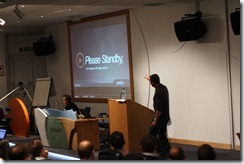PDC10 Round Up
This week’s MSDN Flash features a PDC10 round up by Andrew Sinclair – a valiant effort given Andrew wasn’t there in person but took advantage of the live streaming of PDC10 as well as the on-demand facility. Below are a few photos I took at the Reading event where we were joined by about 200 developers to watch the keynote and breakout sessions. Andrew’s article follows immediately after.
Last week at Microsoft's Redmond Headquarters, hundreds of developers gathered for PDC10. For the first time in its history the Professional Developers Conference was streamed live on the Web. It was also beamed to more than 200 events around the world including Reading, London, Cambridge and Manchester (among others) for UK developers.
Steve Ballmer opened the conference with a keynote focused on building applications in the cloud that run on smart devices, where a smart device is no longer just a PC but might be a phone or TV. "The ability to do … amazing things with software is greater today than at any time in history " he enthused to the packed auditorium.
He went on to describe how the "glue that allows this world to come together and allows for amazing innovation is HTML5". It was noticeable throughout the two days of the conference that Microsoft has fully embraced HTML5 and is emerging as one of the main drivers of this technology.
IE9 was next on the agenda, its main focus being support for standards compliant HTML5 and CSS3 together with rich graphics and increased interactivity. It promises to bring the power of the PC and the power of the Web together, and includes some great new features such as programmable jump lists that are activated when you pin a website to the taskbar in Windows 7. IE9 provides a great platform for web applications; find out more and download IE9 Platform Preview 6 here.
"We nailed it" Steve Ballmer declared whilst describing Windows Phone 7. He clearly has huge expectations for the totally revamped mobile platform. He also triggered the biggest cheer of the conference when he announced that all attendees would be receiving a free phone courtesy of Microsoft. A new profiling tool for optimising Windows Phone 7 applications was announced, and at another session details of a free Microsoft Press book, "Programming Windows Phone 7" were made available (you can download it here).
Ballmer finished his half of the keynote with a plea to us developers, "just load them up with apps, you write those apps". He clearly sees the success of Windows Phone 7 resting not just on the hardware and OS, but also the quality and quantity of the applications available.
Bob Muglia, responsible for Windows Azure, took the reins for the remainder of the keynote and this act alone demonstrated Microsoft's commitment to the cloud. He described the cloud as providing a platform as a service (PaaS) which allows developers to concentrate on building applications and not worry about the infrastructure. There was news of a full version of IIS and Remote Desktop support available on Azure by the end of this year. Team Foundation Server is coming to Azure early next year. More detail about the Azure announcements at PDC10 on the Windows Azure team blog.
One of the most interesting sessions from a developer perspective was Anders Hejlsberg on the future of C# and Visual Basic. He explained that during the 10 years since Microsoft announced the original .NET platform, applications have become increasingly connected, across the Web and using disparate services. This has led to more latency and more UI responsiveness issues.
Addressing these issues using asynchronous programming is the theme of the next versions of C# and VB. The new features will allow you to easily add asynchronous tasks to your programs whilst maintaining the structure of your code. No need to worry about callbacks and threading, the compiler will handle all of that for you.
At one of the Windows Phone 7 sessions, the developers of the Twitter and Facebook applications described the lessons learned during the 3 months they spent building them. This session is essential viewing if you are in any way interested in leveraging your .NET skills on the mobile platform.
The message to take away from PDC 2010? As Ballmer explained: "take advantage of IE9, build those Windows Phone 7 applications and continue to fall in love with Windows Azure".
You can watch all the sessions online at https://player.microsoftpdc.com/
About the Author
Andrew Sinclair specialises in Microsoft technologies and blogs about technology and business. After decades of experience in the finance sector he is now embarking on a new project in the music industry.
You can follow him on Twitter @andsinc
You’ll find him blogging at: https://andysinclair.wordpress.com/








